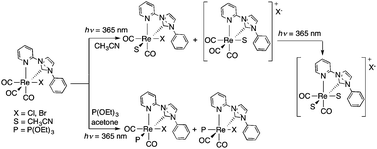The photochemistry of rhenium(i) tricarbonyl N-heterocyclic carbene complexes†
Abstract
The photophysical and photochemical properties of the new tricarbonyl rhenium(I) complexes bound to

* Corresponding authors
a
Department of Chemistry – Curtin University, Kent Street, Bentley 6102 WA, Australia
E-mail:
m.massi@curtin.edu.au, d.h.brown@curtin.edu.au
b
Department of Industrial Chemistry “Toso Montanari” – University of Bologna, viale del Risorgimento 4, Bologna 40126, Italy
E-mail:
stefano.stagni@unibo.it
c Centre for Microscopy, Characterisation and Analysis, University of Western Australia, Crawley 6009 WA, Australia
The photophysical and photochemical properties of the new tricarbonyl rhenium(I) complexes bound to

 Please wait while we load your content...
Something went wrong. Try again?
Please wait while we load your content...
Something went wrong. Try again?
J. G. Vaughan, B. L. Reid, S. Ramchandani, P. J. Wright, S. Muzzioli, B. W. Skelton, P. Raiteri, D. H. Brown, S. Stagni and M. Massi, Dalton Trans., 2013, 42, 14100 DOI: 10.1039/C3DT51614H
To request permission to reproduce material from this article, please go to the Copyright Clearance Center request page.
If you are an author contributing to an RSC publication, you do not need to request permission provided correct acknowledgement is given.
If you are the author of this article, you do not need to request permission to reproduce figures and diagrams provided correct acknowledgement is given. If you want to reproduce the whole article in a third-party publication (excluding your thesis/dissertation for which permission is not required) please go to the Copyright Clearance Center request page.
Read more about how to correctly acknowledge RSC content.
 Fetching data from CrossRef.
Fetching data from CrossRef.
This may take some time to load.
Loading related content
